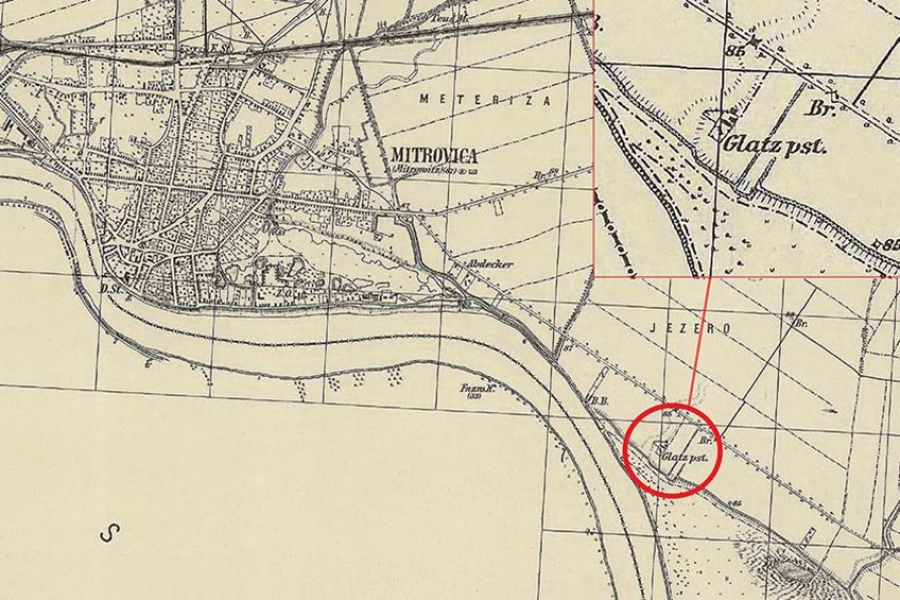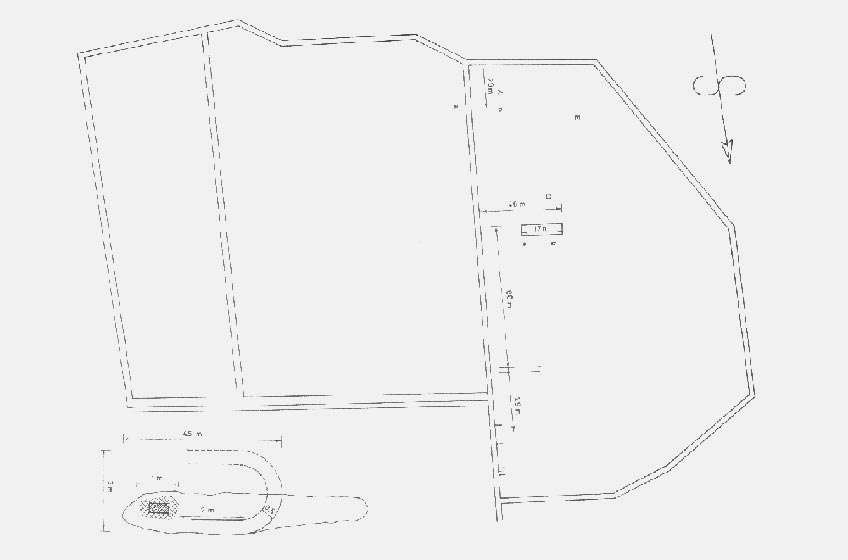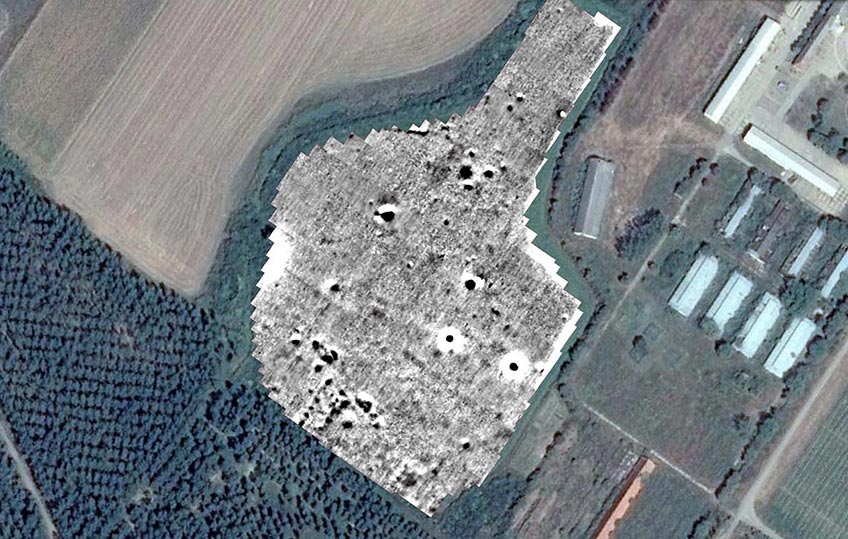Archaeological Site Glac
Arheološko nalazište Glac
The archaeological site Glac is located along the Sava river, 4 kilometres from Sremska Mitrovica, on the road to the village Jarak. In the late antiquity this space was on the outskirts (suburbum) of one of the capitals of the Roman Empire – Sirmium. The name Glac originates from a surname of an inhabitant of Sremska Mitrovica who purchased a field on this location and built a farm there. The toponym Glatz pst., short for Glatz puszta, meaning Glac’s Heath can be found on the late 19th century plans.
Arheološki lokalitet Glac nalazi se pored reke Save, 4 kilometra udaljen od Sremske Mitrovice, na putu prema selu Jarak. U vreme kasne antike ovaj prostor je predstavljao predgrađe (suburbium) jedne od prestonica rimskog carstva – Sirmijuma. Sam naziv Glac potiče od prezimena jednog Mitrovčanina koji je na ovom mestu kupio njivu i sagradio salaš. Na planovima s kraja XIX veka zabeležen je naziv Glatz pst, skraćeno od Glatz puszta, što znači Glacova pustara.

Mapa s kraja XIX veka na kojoj je je obeleženo imanje “Glatz pst”, skraćeno od Glatz puszta. (Arcanum – Digitized Historical Maps)
The earliest knowledge about the existence of an ancient site on Glac’s farm dates to 19th century. The local teacher and Sirmium researcher from Mitrovica, Ignjat Jung, is most renowned for these insights. He recorded the remains of Roman buildings on several locations and described the rooms decorated with luxurious, marble slabs and green porphyry. In one semi-circular room, he discovered a floor covered with a mosaic and bases and shafts of limestone columns. Jung made a site plan, noting a surface of 350 x 200 meters, surrounded by water channels, that looked like a military camp. He believed at that time that Glac’s farm was the site of the military camp of the Avar ruler (khagan) Bayan who besieged Sirmium at the end of the 6th century.
Prva saznanja o antičkim nalazištu na Glacovom salašu potiču s kraja XIX veka. Za njih je najzaslužniji mitrovački učitelj i istraživač Sirmijuma Ignjat Jung. On je zabeležio ostatke rimskih građevina na nekoliko mesta i opisao prostorije ukrašene luksuznim mermernim pločama i zelenim porfirom. U jednoj polukružnoj prostoriji otkrio je pod prekriven mozaikom i baze i stabla stubova od krečnjaka. Sačinivši plan lokaliteta Jung je naveo dimenzije od 350×200 metara ograđenih kanalima što mu je zaličilo na vojni logor. U to vreme je smatrao da se na Glacovom salašu nalazio vojni logor avarskog vladara (Kagana) Bajana koji je opsedao Sirmijum krajem šestog veka.

Prvi plan nalazišta Glac na kojем je Ignjat Jung označio mesta na kojima su otkriveni ostaci rimske arhitekture. (P. Milošević, Sirmium II, 1971, Pl. XIII)
Further data on Roman finds originate from WWI. At that time, the whole area around the Sava River was crisscrossed with trenches and cannon positions of the Austro-Hungarian army. There is a record made by lieutenant Dragutin Trstenjak that reports about an 80-square meter mosaic discovered during digging of the defense trenches. Among other things, the report mentions that a sarcophagus and a head of a marble sculpture were also uncovered.
Unfortunately, up until the end of the 19th century there were no archaeological excavations. In that period a vast amount of the site was used for farming and some parts of the Roman villa were destroyed during the construction of the agricultural property. First research was carried out in 1994 on several locations. It was established that the site extends over several hundreds of meters. A wall of a large building that stretches over several tens of meters as well as rooms decorated with mosaics next to it were then uncovered.
Sledeći podaci o rimskim nalazima potiču iz vremena I svetskog rata. Tada je ceo prostor oko obale Save bio ispresecan rovovima i topovskim položajima Austro-Ugarske vojske. Postoji jedan zapis koji je sačinio poručnik Dragutin Trstenjak koji izveštava o nalazu preko 80 kvadratnih metara mozaika otkrivenog prilikom kopanja odbrambenih rovova. Pored ostalog u izveštaju se pominje da su otkriveni i jedan sarkofag i glava mermerne skulpture.
Nažalost sve do kraja XX veka nije bilo arheoloških iskopavanja. U tom periodu je veliki deo nalazišta služio kao njiva, a pojedini delovi rimske vile su uništeni izgradnjom poljoprivrednog dobra. Prva istraživanja su obavljena 1994. godine na nekoliko mesta i tada je konstatovano da se nalazište proteže na prostoru od više stotina metara, a otkriven je zid velike građevine koji se proteže nekoliko desetina metara i prostorije ukrašene mozaicima pored njega.

Geofizički snimak lokaliteta iz 2014. godine na kojem su uočljivi zidovi ispod tla. (Projekat Glac)
Although the site was legally protected, research only began in 2014 with a geomagnetic survey of the surface of 4ha. The survey recording displayed the existence of the remains of a large building underneath the field that stretches over several hectares. Apart from the geophysical research, each year in late autumn, experts go field walking and collect the material that came up on the surface. Based on numerous finds of decorations made of luxurious marble and porphyry, it could be concluded that Glac is the site where a luxurious, late ancient building complex was built.
The gathered data indicate that a long-term and systematic research should be undertaken with the aim to examine the whole site and interpret its purpose using archaeological methods.
During ancient times, Sirmium was one of the largest urban centres on the territory of the Balkans, with an imperial palace built at the beginning of the 4th century. Apart from the imperial palace in the centre of Sirmium, historical sources mention that the Roman emperor Maximian Herculius built a palace near Sirmium. Given the site Glac lies in the vicinity of the ancient city, it is highly likely that the late-ancient building complex at the site is the palace that was described by Roman writers.
Iako je lokalitet stavljen pod zaštitu istraživanja su započeta tek 2014. godine kada je na prostoru od 4 ha sprovedeno ispitivanje terena geomagnetskom metodom. Dobijen je snimak na kojem se uočavaju ostaci velike građevine koja se nalazi ispod njive i koja se proteže na više hektara. Paralelno sa geofizičkim ispitivanjima svake godine u poznu jesen stručnjaci su obilazili teren i prikupljali materijal koji se pojavljivao na površini. Na osnovu brojnih nalaza ukrasa od skupocenog mermera i porfira moglo se zaključiti da je Glac nalazište na kojem je podignut luksuzan kasnoantički građevinski kompleks.
Svi ovi podaci su upućivali na to da na ovom lokalitetu treba sprovesti dugotrajna sistematska istraživanja koja će imati za cilj da arheološkim metodom ispitaju celo nalazište, i da protumače namenu građevina.
Tokom antike grad Sirmijum je bio jedan od najvećih urbanih središta na teritoriji Balkana, a u samom gradu je početkom IV veka podignuta carska palata. Pored carske palate u središtu Sirmijuma iz istorijskih spisa znamo da je rimski car Maksimijan Herkulije podigao palatu u neposrednoj blizini Sirmijuma. Kako se lokalitet Glac nalazi u neposrednoj blizini antičkog grada veoma je moguće da je kasnoantički kompleks građevina na lokalitetu u stvari palata koja je zabeležena kod rimskih pisaca.

Rеndеr 3d modеla nalazišta Glac tokom iskopavanja. Poglеd sa sеvеra. (Projеkat Glac)

